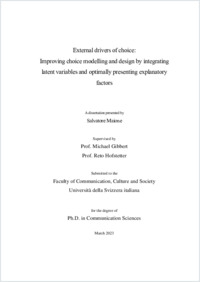External drivers of choice : Improving choice modelling and design by integrating latent variables and optimally presenting explanatory factors
- Maione, Salvatore ORCID
- Gibbert, Michael (Degree supervisor)
- Hofstetter, Reto (Degree supervisor)
- 2023
PhD: Università della Svizzera italiana
Discrete choice experiments
Hybrid choice models
Choice-based conjoint
Hierarchical bayes estimation
Latent variables
Attribute importance
English
In the choice modelling context, characteristics of alternatives, attributes, and attributes’ levels have received great attention from researchers in the past decades. The main objective was to understand how much these variables had an influence on the decision-making process (Kahneman & Tversky, 1979, 1984; McFadden, 1986; Simon, 1956; Tversky & Kahneman, 1986). In recent years, however, several works focused their attention on external characteristics that are mainly connected to the decision maker: latent variables adoption, through hybrid choice models, has given the chance to throw lights on aspects not fully considered until then (Ben-Akiva & Boccara, 1995; Ben-Akiva, Walker, et al., 2002; Vredin Johansson, Heldt, & Johansson, 2006; Walker & Ben-Akiva, 2002; Walker, 2001). Following this research stream, this dissertation studies how intangible (i.e., not directly observable) individuals’ characteristics influence the decision-making process. The first article (Chapter 2) examines, in the context of public transportation, how the introduction of specific train sections based on travelers’ habits and needs can increase the value of train subscriptions. It studies whether including the individuals’ tendency towards out-group derogation influences travelers’ preference for these specific train sections. It demonstrates, through the adoption of a hybrid choice model, that specific groups of individuals with a higher tendency towards out-group derogation indicate a strong preference for subscriptions that include specific train sections. In other words, it highlights how travelers’ heterogeneity, represented in this case by the attitude to distance themselves from others with different characteristics, influences the choice process for a new train subscription. The second article (Chapter 3) investigates, in the context of public transportation, the effect of not directly observable social norms on the subscription choice process beyond the characteristics of the subscription itself. First, it analyses travelers’ preferences for subscriptions with different types of (constrained) access then it examines the effect of social norms on these preferences. It demonstrates that the presence of formal time constraints and professional social norms that affect their working time flexibility have a strong impact on travelers’ subscription preferences. Finally, the third article (Chapter 4) analyses, following the choice design approach adopted in the first two articles of this dissertation, the effect that different choice task layouts in the presentation phase have on the choice process. In the discrete choice experiment (DCE) framework, it examines whether a choice design with informative labels can influence their attribute importance scores compared to a choice design with non-informative labels and an attribute representing the original (and informative) labels. Adopting a choice-based conjoint (CBC) analysis with a Hierarchical Bayes (HB) estimation process, this article demonstrates that respondents ascribe a significant lower importance score to the attribute representing the labels when it has been placed among the other attributes in the choice task (compared to the case in which labels are used as attributes’ titles). With these three articles, this thesis contributes to the understanding of the effect that intangible respondents’ traits have on their choices and highlights how important and sensitive the definition of alternatives’ characteristics and their representation are in the choice design phase.
- Collections
- Language
-
- English
- Classification
- Social sciences
- License
-
License undefined
- Open access status
- green
- Identifiers
-
- NDP-USI 2023COM003
- URN urn:nbn:ch:rero-006-119703
- ARK ark:/12658/srd1324633
- Persistent URL
- https://n2t.net/ark:/12658/srd1324633
Statistics
Document views: 207
File downloads:
- 2023COM003: 75
